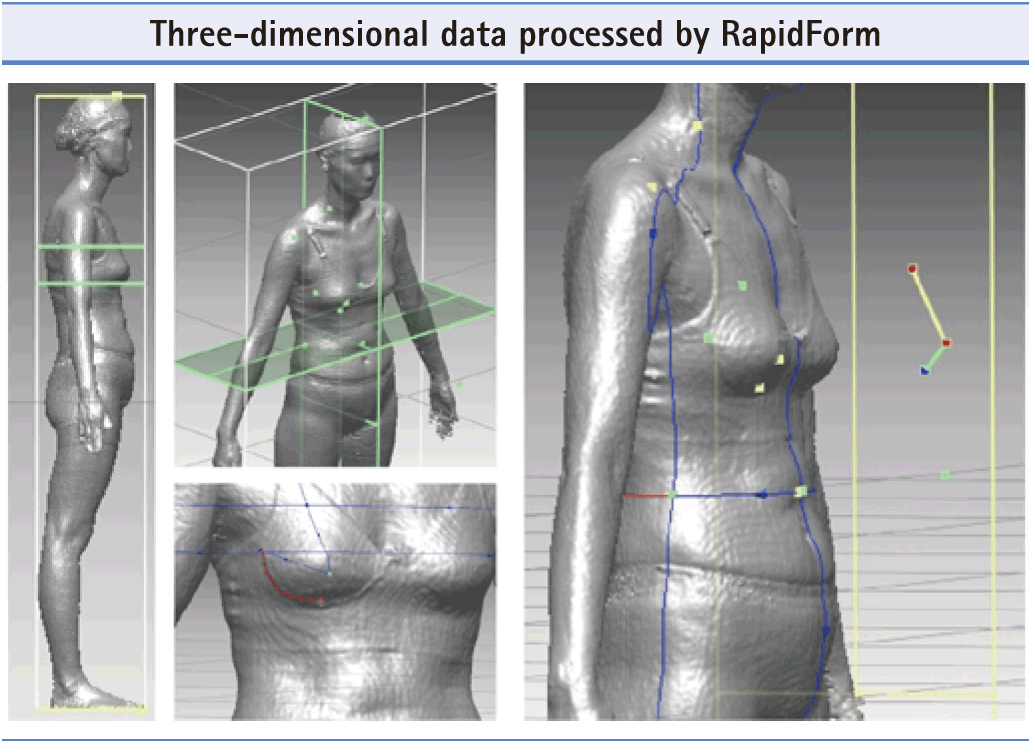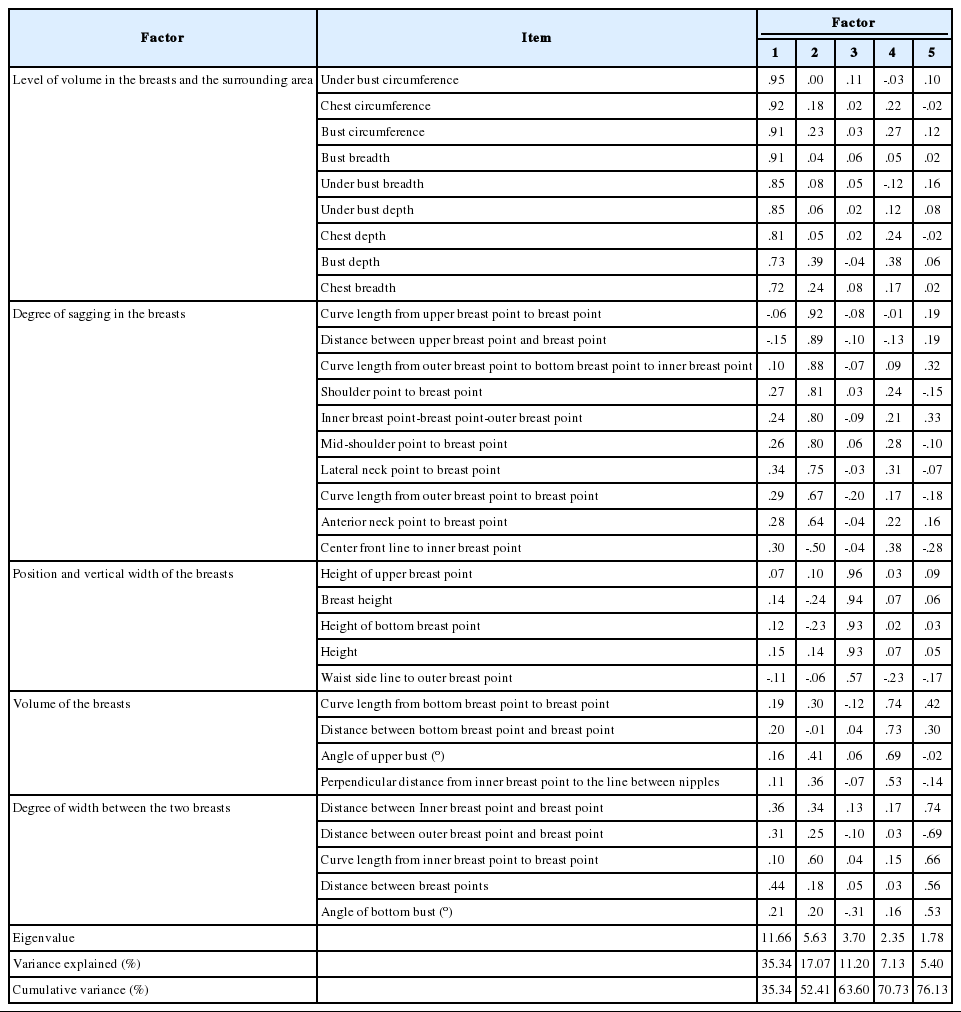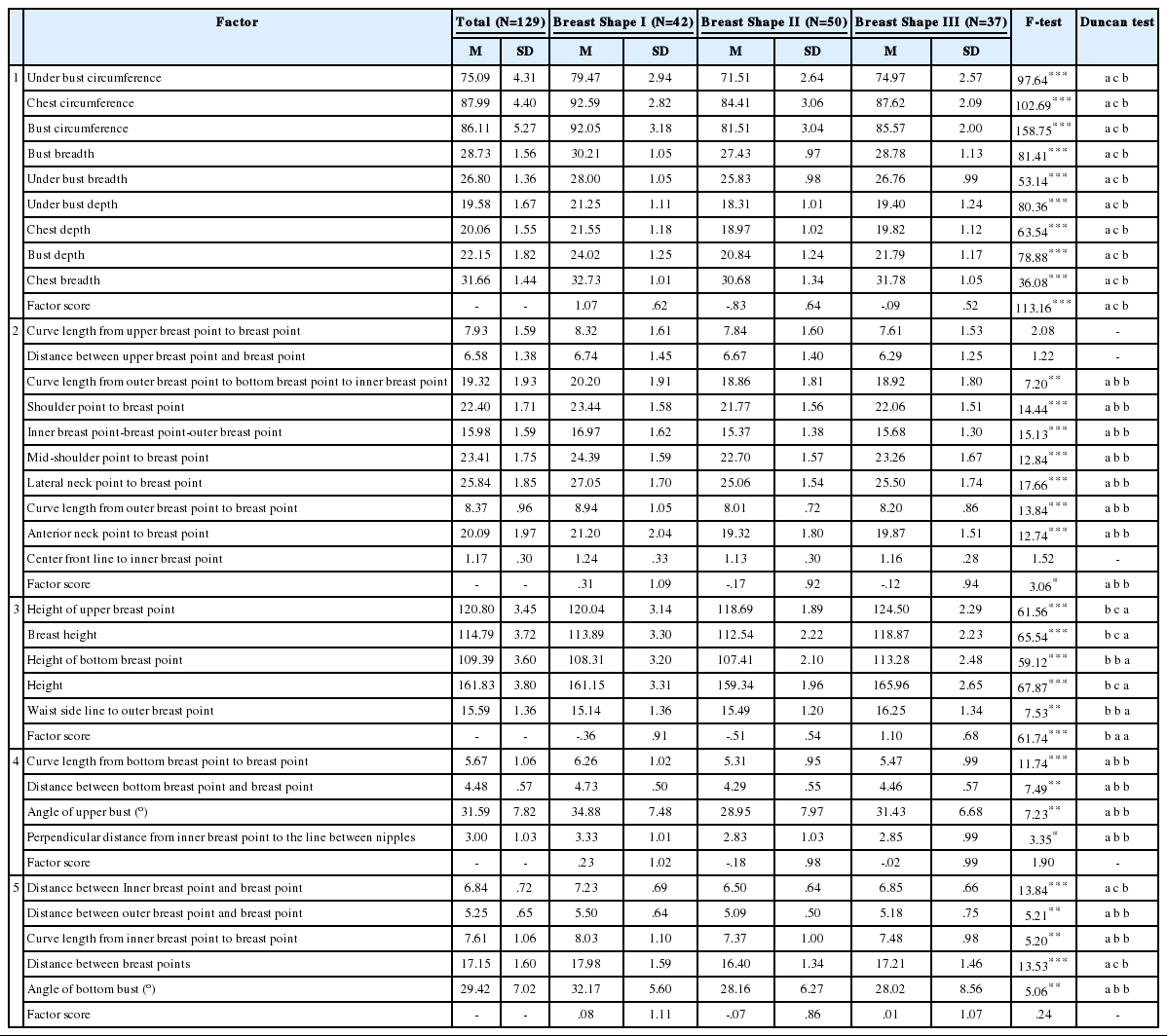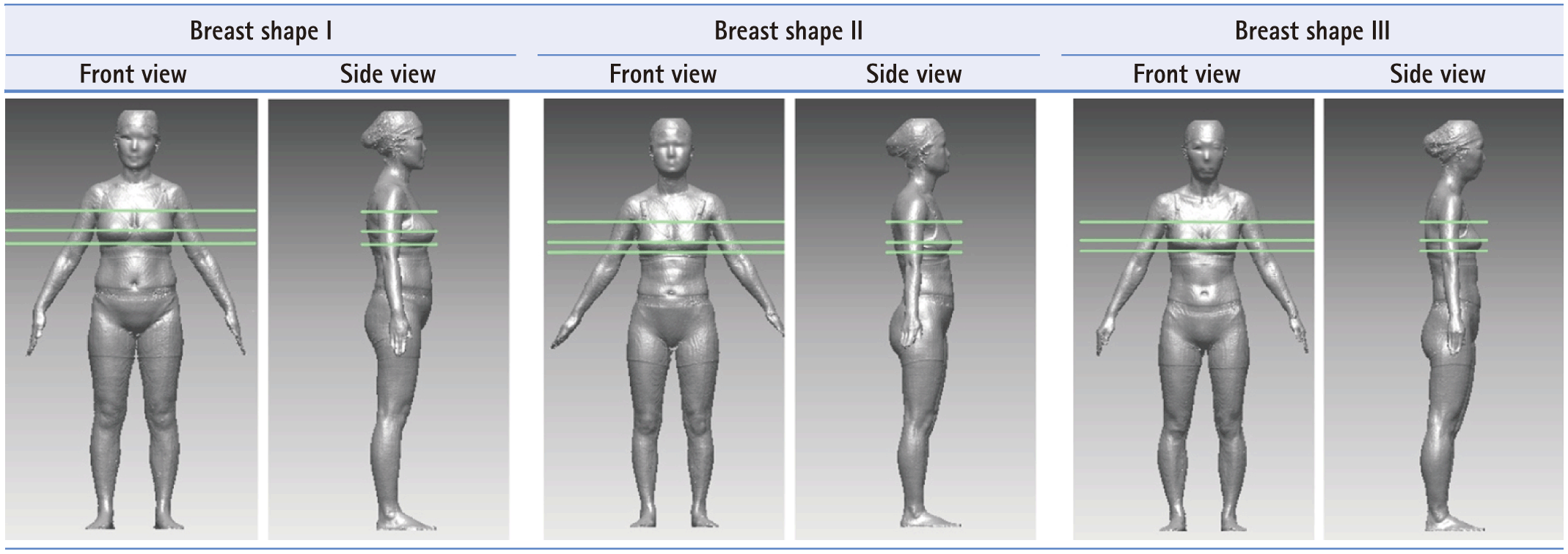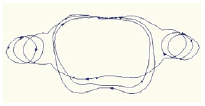3차원 데이터를 활용한 유방유형별 형태 분석: 30대 여성을 중심으로
Analysis of Breast Shapes through the Utilization of 3D Scan Data: A Focus on Women in the Early to Late 30s
Article information
Trans Abstract
This study strives to analyze the characteristics of and changes in breast shapes of women in their 30s, whose bodies start to age and whose breasts experience changes due to internal and external factors such as pregnancy, childbearing, and breast-feeding. The analysis of the indirect breast measurements for each age group (early, mid, and late 30s) demonstrates that the volume of the breasts increases proportionally with age, the breasts lose their firmness, and the nipples start to point downwards rather than to the sides. The breast shapes experience more significant changes vertically than horizontally as the breasts start to sag downwards. The composition factors of the breasts have been classified into five factors: the level of volume in the breasts and the surrounding area, the degree of sagging in the breasts, the position and vertical width of the breasts, the volume of the breasts, and the degree of width between the breasts. The breasts have been categorized into three different shapes. Breast Shape I (32.56%) appeared most frequently among women in their mid 30s, and this shape falls into the category of Sagging I, which is one of the six breast types that have been classified by the Japanese Wacoal Research Center, in addition to Korean size 80A. Breast Shape II (38.76%) appeared most frequently among women in their mid 30s, and this shape has been categorized as flat with its size being 70A. Breast Shape III (28.68%) appeared most frequently among women in their early 30s with a conical shape and size 75A.
서론
여성의 유방은 사춘기 때 호르몬의 영향을 받아 발달하기 시작하여 20대에 가장 이상적인 반구형의 모습을 갖추게 되고 30대 이후 연령증가에 따른 하수현상이 발생하면서 전반적인 체형변화와 함께 형태, 용적, 유두 위치 등 가장 큰 외관적 변화를 보이는 신체 부위이다. 특히 유방부위는 피하 지방이 많아 유동성이 크고 상체 정면에 돌출되어 있기 때문에 형태를 정용(整容)해주어 안정적으로 지지해주고, 등 부분, 겨드랑 아래, 가슴 부위의 군살을 보정하여 상체 실루엣을 아름답게 유지해주는 브래지어에 대한 관심이 높아지고 있으며 그 필요성 또한 강조되고 있다.
현재 시판되고 있는 브래지어는 치수에 따른 맞음새와 기능성 및 디자인 면에서 시장경향을 반영하거나 신체적 변화가 미미한 20대 성인여성의 특징과 치수를 기준으로 하기 때문에 타 연령대 성인여성의 경우 치수 및 형태 부적합으로 인해 브래지어 착용감에 대한 불만이 높은 것으로 보고되고 있다[6, 9, 16]. 연령증가로 인한 유방유형의 변화와 차이를 고려하지 않은 브래지어를 착용할 경우 신체와 브래지어 사이에 들뜸 현상이나 당김, 조임 현상 등이 발생하여 브래지어의 형태가 뒤틀리고 동작 시 당겨 올라가거나 특정부위에 눌림 현상이 나타나 답답함과 불쾌감까지 느껴지게 되어 착용한 여성의 체형변형과 건강에도 영향을 미치므로 각 연령대별로 맞음새와 착용감이 우수한 브래지어 제품을 설계하기 위해서는 연령대별 세분화된 유방 치수와 형태 변화를 고찰한 연구결과가 반영되어야 한다.
특히 성인여성 중 30대는 생물학적으로 본격적인 신체 퇴화가 시작되는 연령대로 초반에서 후반으로 갈수록 연령증가에 따른 체형변이가 두드러지고 임신, 출산, 수유, 사회활동 등 내·외부적 라이프스타일에 따른 신체적 변화가 다양하여 개인별 형태나 치수 차이가 뚜렷해지기 때문에 30대 여성 유방의 형태적 특징 및 차이를 파악하여 유형화하는 데에는 큰 의의가 있다.
이와 같이 여성의 30대가 체형이 달라지는 ‘제2의 체형 성형기’임에도 불구하고 30대 여성의 체형은 보편적인 체형 연령 기준에 명확히 포함되지 않아 유방과 브래지어 관련 선행연구는 성장하는 청소년[1, 4, 18]이나 최상의 신체적 조건을 가진 20대 여성[5, 10, 12, 16] 그리고 40대 이상의 중·장년여성[3, 9, 11]과 노년여성[13, 15, 17]으로 편중되어 있고 30대 여성의 브래지어 연구·개발은 다른 연령층에 비해 상대적으로 미흡하여 새로운 브래지어를 구매해도 지속되는 불만족과 불편함으로 이어지는 악순환이 반복되고 있는 실정이다.
따라서 본 연구에서는 체형변화가 뚜렷해지고 유방의 형태 변화가 심화되는 30대 여성을 대상으로 3D 인체 스캔데이터를 초반, 중반, 후반으로 나눠 영상분석 프로그램으로 간접계측하고 계측 결과를 바탕으로 연령증가에 따른 유방의 형태적 특성 및 변화를 파악하고자 한다. 이를 통해 정형화된 브래지어 치수 체계에 다양성을 추구하고 세분화된 브래지어 개발과 제품생산을 도모하는데 필요한 기초자료를 제공하고자 한다.
연구방법 및 절차
1. 연구대상
본 연구에서는 30대 여성의 유방형태를 분석하기 위해 제6차 한국인 인체치수조사의 3D 인체 스캔데이터가 활용되었다. 연구대상으로 총 192명의 3D 데이터 중 body mass index (BMI) 지수가 정상범위(18.5-22.9 kg/m2)에 해당되고 키구간이 regular(155-160 cm미만, 160-165 cm미만)에 속하는 129명을 추출하였다. 연구대상의 연령은 30대 초반(30-32세) 43명, 30대 중반(33-36세) 50명, 30대 후반(37-39세) 35명의 세 집단으로 분류하였다.
2. 분석항목 및 측정방법
분석항목은 Table 1과 같이 높이항목(4개), 너비항목(3개), 두께항목(3개), 둘레항목(3개), 길이항목(7개), 유방부위세부항목(13개)을 포함하여 총 33항목으로 선정하였다. 유방세부부위 측정을 위한 기준점 용어와 측정방법은 선행연구[8, 14]를 참고하였으며 Table 2에 제시하였다.
제6차 한국인 인체치수 3차원 형상측정을 위한 여성 측정복은 상의, 하의, 측정모로 구성되어 있으며 인체에 밀착되어 들뜸이 없고 인체실루엣을 왜곡 없이 그대로 나타내는 재질로 되어있다. 상의의 경우 사이즈 39종으로 기본신체치수는 젖가슴둘레, 젖가슴둘레-젖가슴아래둘레를 기본으로 하며 하의의 경우 사이즈 37종으로 배꼽수준허리둘레, 엉덩이둘레-배꼽수준허리둘레를 기본으로 한다. 측정모의 경우 사이즈 6종으로 머리둘레 를 주요치수로 사용하며 3 cm편차로 49-64 cm까지 구성되어있다.
3. 자료분석
유방형태 분석자료는 3차원 인체스캐너로 촬영한 인체형상을 RapidForm 2006 (INUS Technology Inc., Korea)을 이용하여 기준점과 기준선을 표시한 후 간접측정 하였으며 측정된 자료는 SPSS ver. 17.0 (SPSS Inc., Chicago, IL, USA) 통계프로그램을 이용하여 기술통계, F-test, Duncan-test, 요인분석, 군집분석, 교차분석 등을 실시하였으며 자료의 분석 과정은 다음과 같다.
첫째, RapidForm 2006을 이용하여 유방측정 부위에 기준점을 만들고, 각각의 기준점에 Plane을 만들어 수직거리, 체표길이를 잰다. 인체형상의 곡선부위에는 형상곡선과 일치하는 경계곡선을 생성하여 측정한다. 유방각도항목의 경우에는 Z축 Plane에 Reference Point를 생성시켜 각도 값을 읽는다(Figure 1).
둘째, 3D 데이터에서 얻어진 항목들을 바탕으로 유방형태의 구성요인을 추출하기 위해 요인분석을 실시하여 요인별 특징을 밝히고 연령집단별로 요인점수를 비교분석한다.
셋째, 요인분석의 결과로 얻어진 항목들을 변수로 군집분석을 실시하여 유방형태를 유형화하고, 평균, F-test, Duncan-test값을 구하여 유형별 유방의 특징을 파악한다.
넷째, 3D 데이터의 유방유형별 대표체형의 상반신 단면도를 살펴보고 유방형태를 확인한다.
연구결과 및 고찰
1. 유방형태의 구성요인 분석
유방형태의 구성요인을 추출하기 위해 총 33개 항목에 대해 요인분석을 실시하였다. 요인의 추출방법은 주성분분석방법으로 Varimax법에 의한 직교회전을 사용하였고 고유치가 1이상인 요인을 추출한 후 Scree-test 결과와 요인의 해석을 고려하여 총 5개의 요인을 결정하였으며 누적기여율은 76.13%이다(Table 3). 각 요인별 요인부하량, 고유치, 변량의 기여율, 요인의 특성은 다음과 같다.
요인1은 둘레·너비·두께항목에서 높은 부하량을 나타내 ‘가슴부위 비만 정도를 나타내는 요인’이라고 할 수 있다. 젖가슴아래둘레(.95), 가슴둘레(.92), 젖가슴둘레(.91), 젖가슴너비(.91) 등의 순으로 부하량이 높게 나타났으며, 5개 요인 중 가장 값이 큰 요인으로 고유치는 11.66, 변량기여율은 35.34%로 나타났다. 요인2는 유방상부길이(.92), 유방상부직경(.89), 유방밑윤곽선길이(.88), 어깨끝점~젖꼭지점(.81), 유방원주(.80) 등의 항목에서 부하량이 높게 나타나 ‘유방의 처짐을 나타내는 요인’이라 할 수 있다. 이 요인의 점수가 높으면 유방의 하수 정도가 심하다고 할 수 있으며, 고유치는 5.63, 변량기여율은 17.07%로 나타났다. 요인3은 유방상연점높이(.96), 유방높이(.94), 유방하연점높이 (.93), 키(.93) 등 높이항목의 부하량이 높게 나타나 ‘유방위치 및 수직크기를 나타내는 요인’이라 할 수 있고, 고유치는 3.70, 변량기여율은 11.20%로 나타났다. 요인4는 유방하부길이(.74), 유방하부직경(.73), 유방상부경사각도(.69) 등의 항목에서 높은 부하량을 나타내 ‘유방의 볼륨을 나타내는 요인’이라 할 수 있다. 고유치는 2.35, 변량기여율은 7.13%로 나타났다. 요인5의 유방내측직경(.74), 유방내측길이(.66), 젖꼭지간격(.56), 유방하부경사각도(.53) 항목은 양의 방향으로 높게 부하하였고 유방외측직경(-.69)은 중정도의 음의 값을 나타내 ‘유방의 벌어짐을 나타내는 요인’이라 할 수 있다. 고유치는 1.78, 변량기여율은 5.40%로 나타났다.
요인분석 결과 추출된 5개의 요인에 대하여 연령 집단별 차이를 검증하기 위해 요인점수를 구하고 F-test, Duncan-test를 실시한 결과는 Table 4와 같다.
연령 집단별로 유의한 차이가 나타난 요인은 요인3과 4로 연령증가에 따라 요인점수가 낮아져 30대 초반이 가장 높은 점수를 보였고, 30대 후반이 가장 낮은 점수를 나타냈다. 즉 연령이 증가할수록 키를 비롯한 전반적인 신체 수직크기가 감소하여 유방의 위치가 낮아지고 중력의 영향과 출산 및 수유 등으로 인한 유방하수경향으로 볼륨감이 줄어들었음을 알 수 있다.
요인1과 2에서는 연령 집단별 유의한 차이는 인정되지 않았으나 연령이 증가할수록 요인점수가 커져 30대 후반이 30대 초반보다 가슴부위의 비만정도와 유방의 처짐이 심화되는 것으로 분석되었다.
이와 같이 30대 여성 유방형태는 연령증가, 임신, 출산, 수유 등으로 가슴부위의 비만화 경향이 심화되고 유방의 용적이 커지며 유방의 벌어짐보다는 처짐 및 하수로 인하 형태 변화가 뚜렷해지는 특징을 보이는 것으로 나타났다.
2. 유방형태의 유형화
30대 여성의 유방형태를 분류하고 그 특징을 파악하기 위해 요인분석에서 얻어진 항목들을 변수로 하여 군집분석을 실시하였다. 군집분석 결과 총 3개의 유형으로 분류되었으며, 선정된 3개 집단의 특징을 잘 나타낼 수 있는 명칭을 부여하기 위하여 군집별 신체치수와 요인점수의 차이를 F-test와 Duncan-test로 분석하여 Table 5에 제시하였다. 유방유형별 대표체형의 정면과 측면은 Figure 2와 같다.
유방유형 I은 요인3에서는 3개 유형 중 중간정도 크기를 나타내고, 나머지 요인1, 2, 4, 5에서는 3개 유형 중 가장 큰 값을 나타냈다. 요인3의 항목을 제외하고는 모든 항목에서 전체평균보다 큰 값을 보여 전반적으로 유방용적이 크고, 유방의 벌어짐과 처짐의 정도도 다른 유형에 비해 크게 나타나 일본 와코루(Wacoal) 인간과학연구소의 유방형태 분류의 6유형 중 하수형 I에 속한다. 유방유형 I은 브래지어 치수규격 80A에 해당되며 유방의 용적을 고려하여 두껍지 않은 직조 혹은 부직포 재질의 컵 하단에 메쉬 테이프(mesh tape)를 삽입하면 통기성과 쾌적성이 향상될 것으로 판단된다. Table 6의 유방유형에 따른 연령집단 분포율을 살펴보면 총 42명으로 전체의 32.56%를 차지하였고 특히 30대 중반에서 13.95%의 출현율을 보였다.
유방유형 II는 총 50명으로 전체의 38.76%를 차지하고 있으며 특히 30대 중반에서 15.50%의 높은 출현율을 보이고 30대 초반과 후반에서는 각각 11.63%로 고른 분포를 보였다. 가슴부위 비만 정도를 나타내는 요인1에서는 3개 유형 중 가장 작게 나타났고, 유방의 처짐과 유방의 볼륨을 나타내는 요인2와 4에서도 유방유형 III과 같이 가장 작은 집단으로 분류되었다. 요인3에서는 유방상연점높이, 유방높이, 키 항목은 3유형 중 가장 작은 값을 나타냈고, 유방하연점높이와 옆선~유방외연점은 유방유형 I과 같은 집단으로 나타났다. 요인5에서는 유방내측직경과 젖꼭지 간격 항목의 경우 3개 유형 중 가장 작은 값을 나타내었고, 나머지 항목은 유방유형 III과 같은 집단으로 분류되었다. 또한 유방상부직경항목을 제외한 모든 항목에서 전체평균값보다 작은 값으로 나타나 유방의 용적이 작고 처짐과 벌어짐, 유방의 상·하부 경사각도도 작아 전체적으로 밋밋한 유방형태임을 알 수 있다. 따라서 유방유형 II는 납작형으로 볼륨업 패드와 와이어가 삽입된 몰드컵이 적절하며 브래지어 치수규격은 70A에 해당된다.
유방유형 III은 총 37명으로 전체의 28.68%를 차지하고 30대 초반에서 13.95%로 높은 출현율을 보였다. 유방의 위치 및 수직 크기를 나타내는 요인3은 3개 유형 중 가장 큰 값을 나타내고 나머지 요인은 모두 중간 값으로 나타났다. 유방유형 III은 원추형에 해당되고 브래지어 치수규격은 75A에 속하며 다른 유방유형에 비해 컵의 재질과 형태의 제약을 비교적 덜 받는다.
유방유형별 요인점수를 살펴보면, 요인1-3에서 유의한 차이가 인정되었고, 요인1은 유방유형 I, 유방유형 III, 유방유형 II의 순으로 크게 나타났다. 요인2는 유방유형 I에서 가장 큰 값을 나타냈고, 요인3은 유방유형 III에서 가장 크게 나타나 요인별 신체치수와 일치하는 결과를 보였다. 유방의 볼륨과 유방의 벌어짐을 나타내는 요인4와 5에서는 유의한 차이가 인정되지 않았지만 유방유형 I에서 가장 큰 값으로 나타났다.
유방유형에 따른 연령집단의 인원분포율은 유방유형 II (납작형, 38.76%), 유방유형 I (하수형, 32.56%), 유방유형 III (원추형, 28.68%)의 순으로 크게 나타나지만 30대 여성의 유방형태는 특정 연령집단에 집중적으로 분포되어 있기보다는 전체 연령집단에서 비교적 고르게 분포되어 있다.
선행연구의 결과와 비교해 보면, Cho [2]의 연구에서는 제5차 한국인 인체치수조사 3차원 인체형상 데이터를 이용하여 30대 여성 174명의 유방유형분석 결과 일본 와코루 인간과학연구소의 유방분류 명칭을 사용하여 빈약형(20.1%), 하수형(29.3%), 반구형(28.2%), 돌출형(22.4%)의 4개 유형으로 분류하였고 비교적 고른 분포를 보였다. Kim [7]의 연구는 20-50대 성인여성 220명을 대상으로 유방유형을 분류하였고 이 중 30대 여성의 유방유형을 총 6개로 나누었으며, 납작형(유형3, 36.0%), 반구형(유형5, 32.4%), 납작형과 반구형의 중간형(유형6, 27.9%)에서 높은 분포율을 보였다. 이와 같이 30대 여성의 유방형태는 다양한 형태에서가 전체 연령대에서 고르게 분포되었으며 특히 용적이 작고 밋밋한 유방유형이 가장 높은 분포를 보여 본 연구의 결과와 일치하였다.
3. 유형별 유방의 단면도 형태
대표 유방유형별 가슴둘레, 젖가슴둘레, 젖가슴아래둘레의 단면도와 너비에 대한 두께의 크기를 판단할 수 있는 편평률을 나타낸 결과는 Table 7과 같다.
가슴둘레의 단면도와 가슴편평률을 살펴보면, 유방유형 I은 .66으로 .62로 나타난 유방유형 II와 유방유형 III보다 더 큰 값을 나타내 형태면에서 크기가 가장 큰 것으로 분석되었다.
젖가슴둘레의 단면도와 젖가슴편평률을 살펴보면, 유방유형 I은 .80으로 유방유형 II와 유방유형 III보다 형태면에서 크기가 크고 단면도의 S1과 같이 유방이 더 뚜렷이 돌출되어 있음을 알 수 있다. 유방유형 II와 유방유형 III은 .76으로 동일한 편평률을 나타내지만 젖가슴둘레의 길이가 유방유형 II는 81.51 cm, 유방유형 III은 85.57 cm로 차이를 보여 아래 단면도의 S2, S3와 같이 유방유형 II는 납작형, 유방유형 III은 원추형으로 유방부위 형태가 다르게 나타났다.
젖가슴아래둘레의 단면도와 젖가슴아래편평률은 유방유형 I(.76), 유방유형 III (.72), 유방유형 II (.71)의 순으로 나타났다. 특히 유방유형 II는 .71로 가장 작은 값을 보여 젖가슴아래부분이 납작한 형태로 분석되었다.
결론 및 제언
본 연구는 3D 인체 스캔데이터를 활용하여 키구간이 regular에 속하면서 BMI지수가 정상범위에 해당하는 30대 여성의 연령 증가에 따른 유방형태와 변화를 분석하였다. 연령 집단별로 측정치의 변화를 살펴본 결과 연령이 증가할수록 피하지방의 침착으로 너비·두께·둘레항목의 값이 증가하여 유방부위의 비만도가 심화되는 것으로 나타났다. 길이항목에서는 유방 하수현상의 진행으로 연령이 증가할수록 젖꼭지점의 위치가 낮아져 값이 증가하였고, 유방세부항목에서는 유방의 벌어짐보다는 처짐으로 인한 형태변화가 더 두드러지는 것으로 파악되었다.
유방형태의 요인분석 결과 총 5개의 요인으로 분류되었다. 요인1은 ‘가슴부위 비만 정도를 나타내는 요인,’ 요인2는 ‘유방의 처짐을 나타내는 요인,’ 요인3은 ‘유방위치 및 수직크기를 나타내는 요인,’ 요인4는 ‘유방의 볼륨을 나타내는 요인,’ 요인5는 ‘유방의 벌어짐을 나타내는 요인’으로 분석되었다.
유방형태 군집분석 결과 총 3개의 유형으로 분류되었으며 유방유형 I (32.56%), 유방유형 II (38.76%), 유방유형 III (28.68%) 순으로 비교적 고른 분포를 보였다. 유방유형 I은 30대 중반에서 13.95%의 높은 출현율을 보이고 하수형I의 형태로 브래지어 치수규격은 80A에 해당된다. 유방유형 II는 30대 중반에서 15.50%의 높은 출현율을 나타내며 납작형으로 분류되고 브래지어 치수규격은 70A에 해당된다. 유방유형 III은 30대 초반에서 13.95%의 높은 출현율을 보이고 원추형으로 분류되며 브래지어 치수규격은 75A에 해당된다. 유방유형별 가슴둘레, 젖가슴둘레, 젖가슴아래둘레의 단면도와 편평률은 유방유형 I이 가장 큰 값을 나타내 볼륨이 크고 벌어짐의 정도가 심한 것으로 확인되었다. 유형II와 III은 가슴둘레와 젖가슴둘레의 편평률은 동일하지만 둘레길이와 유방상부경사각도 등의 값이 다르게 나타나 유방의 형태에는 차이가 있었다.
본 연구에서 활용한 제6차 한국인 인체치수조사의 3D 인체 스캔데이터는 피측정자에게 측정복을 착용하게 하여 유방부위에 약간의 보정이 이루어졌기 때문에 누드 상태로 측정한 데이터 결과와는 차이가 있을 수 있다. 다만, 제6차 측정에서 사용된 측정복은 제5차 한국인 인체치수조사 측정에 사용된 측정복보다 들뜸 현상이나 유방형태의 변형 정도가 완화되어 유방을 포함한 상반신 치수 계측 시 기준점이 명확히 드러나 스캔데이터 내에서 정확한 계측치수를 구할 수 있었다. 본 연구를 위한 유방형태의 표본추출은 제6차 한국인 인체치수조사의 30대 여성 3D 데이터를 중심으로 이루어졌으므로 연구결과를 확대 해석하는데 신중을 기해야 할 것이다. 향후 연구에서는 누드상태와 측정복을 착용한 상태에서 계측한 값의 비교연구가 이루어져야 할 것이며 보다 폭넓은 연령계층의 유방형태 연구와 세분화된 사이즈 체계 수립을 위해 연령계층간의 비교분석을 수행하여 연구의 폭을 확대할 필요가 있다.
Notes
The authors declared that they had no conflicts of interests with respect to their authorship or the publication of this article.


